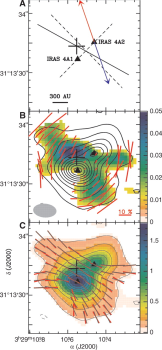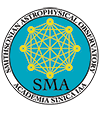|
Magnetic Fields in Star Forming Regions
In the classical picture of star formation, magnetic fields are believed to strongly influence star formation activity in molecular clouds. They provide support to a cloud against gravitational collapse and thus explain the low efficiency of the star formation process (Shu 2007). The process of ambipolar diffusion, in which magnetic flux is redistributed in the cloud, leads to the formation of a core that can no longer be magnetically supported and gravitational collapse sets in. In addition, the process of magnetic braking can help to remove angular momentum and slow down the rotation of the cloud as it collapses.
In contrast there have been a number of competing theories that postulate that magnetic fields are weak and supersonic magnetohydrodynamic turbulence is the dominant process (Mac Low 2004). Turbulence controls the evolutions of clouds, and cores form at the intersection of supersonic turbulent flows. Only a fraction of such cores become supercritical and collapse begins to occur on a gravitational free-fall timescale. Studying the morphology of the magnetic field in the interstellar medium (ISM) requires difficult and sensitive observations of polarized radiation from dust grains that become aligned in the presence of a magnetic field (Hildebrand 1984). Earlier measurements of this effect with other telescopes suffered either from lack of sensitivity or lack of angular resolution. Emission from dust is strongest at submillimeter wavelengths and observations made by interferometric arrays can produce the detailed maps needed. Presently, the Submillimeter Array (SMA) is the only array that can detect the polarized emission at mm and submm wavelengths.
Low Mass Stars a) NGC 1333 IRAS4A: The SMA has been used to map the magnetic field around a number of nearby bright low mass star forming regions. The first object chosen for this study was the star forming region NGC 1333 IRAS 4A. This is a Class 0 protostar which has been resolved into a binary system with a separation of around 1 arcsecond. These results have been reported in the journal Science (Girart, Rao, & Marrone 2006) and, for the first time, show that in a low-mass star forming region the observed properties of the magnetic field are in agreement with the standard theoretical models of isolated star formation in magnetized molecular clouds: the magnetic field traces a clear hourglass morphology (figure 2). On larger scales the polarization direction is quite uniform and is in excellent agreement with earlier lower resolution observations. However, on small scales (around 200 AU) the field is significantly distorted or "pinched" and the morphology resembles the hour glass shape that is predicted by theory. The symmetry axis for the magnetic field appears to be approximately perpendicular to the major axis of the extended disk.

Click here for larger view
| Figure 2: Polarization in NGC 1333 IRAS 4A: (A) Sketch of the axis directions: red/blue arrows show the direction of the redshifted/blueshifted lobes of the molecular outflow, solid lines show the main axis of the magnetic field, and dashed lines show the envelope axes. The solid triangles show the position of IRAS 4A1 and 4A2. The small cross shows the centre of the magnetic field symmetry. (B) Contour map of the 877 µm dust emission (Stokes I) superposed with the color image of the polarized flux intensity. Red vectors: Length is proportional to fractional polarization and the direction is position angle of linear polarization. The synthesized beam is shown in the bottom left corner. (C) Contour and image map of the dust emission. Red bars show the measured magnetic field vectors. Grey bars correspond to the best fit parabolic magnetic field model. Using this fit, we are able to determine the residuals with which the strength of the magnetic field can be estimated with the Chandrasekhar-Fermi method (Girart, Rao, & Marrone 2006). |
Low Mass Stars b) IRAS16293 A/B: This star forming region is also a Class 0 object similar in nature to NGC 1333 IRAS 4A that was discussed previously and a binary star system as well. In this case the binary separation on the plane of sky is much larger. The SMA results (Rao et al. 2009) show that the large scale direction of the field appears to be along the ridge of dust where there is maximum emission. However, on smaller scales, we find that the field structure is completely different for the two components of the binary: component A shows a magnetic field structure which is hour-glass shaped while component B shows an ordered magnetic field. In conjunction with other observations of the kinematics and chemistry we find that the two protostars appear to be in different stages during their evolution.
» Next Page: Magnetic Fields in High Mass Star Formation
« Previous Page
SMA Research
| 

